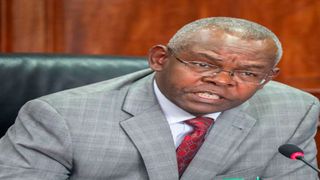Breaking News: Former Lugari MP Cyrus Jirongo dies in a road crash

Central Bank of Kenya (CBK) Governor Kamau Thugge.
| File | Nation Media GroupBusiness
Premium
CBK hits borrowers with highest loan rate in 12 years
The Central Bank of Kenya (CBK) has raised borrowing costs to highs last seen nearly 12 years ago, as it moved to contain stubborn inflation and pull a handbrake on the free fall of the Kenya shilling.
The banking sector regulator on Tuesday increased its base lending rate by 50 basis points from 12.5 percent to 13 percent, a level last witnessed in the sunset years of President Mwai Kibaki’s administration.
The decision has effectively given commercial banks the signal to increase their lending rates, setting up borrowers for a new era of expensive loans.
The new rate will push interest rates for high-risk borrowers beyond 24 percent, with those already servicing bank loans and mortgages expected to take an immediate hit.
The rate increase also signals higher borrowing costs for the government, which relies on the domestic credit markets to finance part of its expenditures.
On Tuesday, the CBK’s monetary policy committee (MPC) tightened its policy rate for the second straight meeting after raising the Central Bank Rate from 10.5 percent to 12.5 percent at its December meeting.
The latest move to raise the benchmark lending rate has been attributed to continued inflationary and exchange rate pressures despite December’s jumbo rate increase.
“The MPC noted that overall inflation has remained sticky in the upper bound of the target range. The committee further observed that all key components of inflation had increased in January. In addition, the MPC noted the continued, albeit reduced, pressures on the exchange rate and therefore concluded that further action was needed to stabilise prices,” the CBK said in a statement on Tuesday.
Overall inflation edged upwards in January to a three-month high of 6.9 percent from 6.6 percent in December to remain sticky in the upper bound of the government’s target range while core inflation-non-food/non-fuel inflation increased to a three-month high of 3.6 percent.
“The risks to inflation remain elevated in the near term, reflecting the impact of second-round effects of the rise in fuel inflation, and pass-through effects of exchange rate depreciation,” the CBK said.
While volatility in the foreign exchange rate has eased considerably over recent weeks, the shilling has continued weakening against major world currencies, shedding 2.1 percent of its value against the US dollar to trade at Sh160.35 as of Monday, according to CBK data.
Despite the CBK’s monetary policy tightening cycle which began in March 2022, key economic indicators, including private sector credit growth, have remained buoyant.
Commercial bank lending to the private sector, for instance, rose to 13.9 percent in December compared to 13.2 percent in November despite concerns of deteriorating asset quality from elevated borrowing costs to clients.
The banking industry's gross non-performing loans to gross loans eased slightly to 14.8 percent in December 2023, compared to 15.3 percent in October 2023, which had represented a 16-year high record of bad loans.
Strong credit growth was observed in manufacturing, transport and communication, trade, and consumer durables. Decreases in non-performing loans were noted in energy and water, manufacturing, agriculture, building and construction, and transport and communication.
“The number of applications and approvals remained resilient, reflecting sustained demand, particularly for working capital requirements,” the CBK noted.
Tuesday’s rate increase was against wide market expectations for a hold in the benchmark lending rate with participants still assessing the effects of the last rate increase.
Kenya Bankers Association (KBA), the banking sector lobby, had called for a pause to the CBK interest increases, warning higher borrowing costs could trigger greater credit defaults in the industry.
“Concerns in the credit market mainly include the deteriorating quality of loans and its impact on credit growth as well as provisions for expected credit losses going forward,” KBA said in a note.
The impact of the fresh interest rate increase is expected to manifest itself first in the short-term interest rate including the overnight lending rate between commercial banks or interbank rate.





